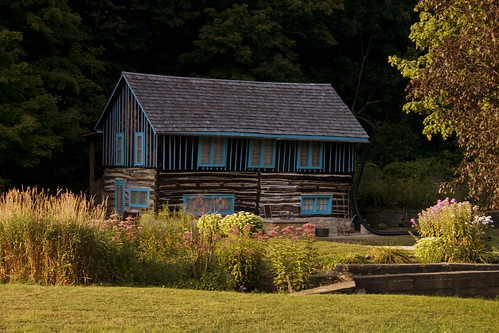Social Essays
Norwegian Barn

The foothills and wooded valleys in the open rolling countryside of Wisconsin reminded Norwegians of their homeland. Pictured here is a typical barn with notched wood beam construction. It was bigger than the actual living quarters for the family.
The barns were just as pretty as any other building. Used to drab winters, the habit of using bright, pleasing colors is shown here, though it's likely that such brightly colored paint was hard to come by for the early pioneers.
Traditional farms would have one building to store household items such as flour, flat bread, canning supplies and clothes, while another would provide a place to bake the flat bread, wash the clothes and heat water for butchering. The Norwegian reliance on small outbuildings became obsolete with the introduction of the sawmill in the U.S., which provided pre-cut timber. This allowed buildings to become large enough to serve many purposes inside.
Adjusting to the American diet was a challenge to those from Norway. They were accustomed to a diet of milk and porridge, flat bread - or lefse - which is unleavened potato bread, and dried meat and fish. In their new land there was a heavy reliance on pork, which the Norwegians found hard to digest on a regular basis, especially without an abundance of vegetable crops. Eventually, new meats such as beef, veal, mutton and lamb replaced pork.
Coffee, however, unknown or too expensive to have in Norway, found ready acceptance by these pioneers in the Midwest. In fact, coffee drinking quickly assumed the rank of an established social institution among Norwegian Americans.
Sugar, in limited supply in Norway, was another welcome confection in their new land. Norwegians also developed a fondness for candy, sweet cakes and pies which were infused with molasses, maple syrup, or honey.
The barns were just as pretty as any other building. Used to drab winters, the habit of using bright, pleasing colors is shown here, though it's likely that such brightly colored paint was hard to come by for the early pioneers.
Traditional farms would have one building to store household items such as flour, flat bread, canning supplies and clothes, while another would provide a place to bake the flat bread, wash the clothes and heat water for butchering. The Norwegian reliance on small outbuildings became obsolete with the introduction of the sawmill in the U.S., which provided pre-cut timber. This allowed buildings to become large enough to serve many purposes inside.
Adjusting to the American diet was a challenge to those from Norway. They were accustomed to a diet of milk and porridge, flat bread - or lefse - which is unleavened potato bread, and dried meat and fish. In their new land there was a heavy reliance on pork, which the Norwegians found hard to digest on a regular basis, especially without an abundance of vegetable crops. Eventually, new meats such as beef, veal, mutton and lamb replaced pork.
Coffee, however, unknown or too expensive to have in Norway, found ready acceptance by these pioneers in the Midwest. In fact, coffee drinking quickly assumed the rank of an established social institution among Norwegian Americans.
Sugar, in limited supply in Norway, was another welcome confection in their new land. Norwegians also developed a fondness for candy, sweet cakes and pies which were infused with molasses, maple syrup, or honey.